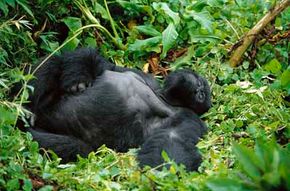Gorilla Nest Building
One of the most common ways that wildlife experts estimate the number of gorillas in an area is to count the number of nests, which are often easier to spot than the actual apes [source: Sanz et al]. Gorilla nest building usually occurs in trees or on the ground, and these apes use branches and leaves as their mattresses. Usually, ground nests are made of herbaceous plants, but the materials vary according to season and what's available [source: Tutin et al]. Generally, they construct their beds more often on the ground than in trees [source: Iwata and Ando]. This nest-building behavior isn't unique to gorillas. In fact, all great apes build nests [source: Iwata and Ando]. Just like your bed at home, ape nests provide comfort, warmth and protection.
However, the handmade lodgings are more like sleeping bags than beds since they're intended for temporary use. Great apes practice nomadic living patterns, migrating from place to place in accordance with fruit or vegetation abundance. On average, gorilla troops travel 0.24 to 0.60 miles (400 to 1,000 meters) daily [source: SeaWorld]. As vegetarians, their diet relies on seasonal crops and plants. And as the largest of the great ape species, gorillas can put away a heap of food. The average adult male gorilla will eat up to 40 pounds (18 kilograms) of fruits and veggies each day [source: San Diego Zoo].
Advertisement
Chimpanzees may reuse old nests, especially near trees that are bearing fruit [source: Iwata and Ando]. Gorillas, on the other hand, rarely sleep in the same nest twice and build a fresh one every evening. In a study on the reuse of western lowland gorilla nests, these animals slept in only 4.1 percent of existing beds more than once [source: Iwata and Ando]. Illustrating their preference for fresh bedding, the gorillas returned to more than a third of original bedding sites and made new ones [source: Iwata and Ando].
Abandoned nests hold a wealth of information about their former tenants that researchers use to assess the health of ape groups. First, there's the number of nests, which gives an approximation of the population size. Adults sleep in their own individual nests, but baby gorillas sleep with their mothers until the age of 3, after which they'll build their own nests [source: Estes and Otte]. Second, researchers can extract hair samples in order to examine individuals' health. And finally, we can't leave out the importance of feces. Droppings indicate food abundance and contain olfactory distinctions between the different species for precise identification.
Some primatologists and evolutionary biologists consider nest building to be a form of behavioral adaptation passed along to hominids [source: McGrew et al]. Observation of nesting behavior has highlighted social aspects involved with this form of bedding. Within these nests, gorilla troops sleep in groups, groom each other, play together and sometimes mate [source: Pi et al]. Also, since all great apes share this nest-building behavior, that makes it more probable that the behavior evolved from a common ancestor rather than developing independently in each species [source: McGrew et al].
So the next time you feel a pang of guilt about splurging on your 500-thread count Egyptian cotton sheets and down comforter, you can put your mind at ease. Comfortable bedding is a natural creature comfort.
Related HowStuffWorks Articles
More Great Links
- AnimalPlanet.com
- SeaWorld: Gorillas
- The Gorilla Organization
- Animal Planet: Gorilla Encounters
Sources
- Estes, Richard and Otte, Daniel. "The Behavioral Guide to African Mammals." University of California Press. 1991. (Aug. 25, 2008)http://books.google.com/books?id=g977LsZHpcsC
- "Gorillas." SeaWorld. (Aug. 25, 2008)http://www.seaworld.org/animal-info/info-books/gorilla/behavior.htm
- Iwata, Yuji and Ando, Chieko. "Bed and bed-site reuse by western lowland gorillas (Gorilla g. gorilla) in Moukalaba-Doudou National Park, Gabon." Primates. 2007. (Aug. 25, 2008)http://www.ncbi.nlm.nih.gov/pubmed/17106788
- Lukas, Kristen E.; Stoinski, Tara S.; Burks, Kyle; Snyder, Rebecca; and Bexell, Sarah; "Mammals: Gorilla." San Diego Zoo. (Aug. 25, 2008)http://www.sandiegozoo.org/animalbytes/t-gorilla.html
- Maple,Terry L. "Nest building in captive Gorilla gorilla gorilla." International Journal of Primatology. 2003. (Aug. 25, 2008)http://cat.inist.fr/?aModele=afficheN&cpsidt=14504758
- McGrew, William Clement; Marchant, Linda Frances; Nishida, Toshisada; Goodall, Jane; and Itani, Junichiro. "Great Ape Societies." Cambridge University Press. 1996. (Aug. 25, 2008)http://books.google.com/books?id=iGfjJ4lKb1IC
- Nielsen, John. "'Mother Lode' of Gorillas Found in Congo Forests." NPR. Aug. 5, 2008. (Aug. 25, 2008)http://www.npr.org/templates/story/story.php?storyId=93254830
- Pi, Jordi Sabater; Veà, Joaquim J.; and Serrallonga, Jordi. "Did the first hominids build nests?" Current Anthropology. December 1997. (Aug. 25, 2008)http://www.jstor.org/pss/2744480
- Ravilious, Kate. "Ebola Killing Thousands of Gorillas, Study Says." National Geographic. Dec. 7, 2006. (Aug. 25, 2008)http://news.nationalgeographic.com/news/2006/12/061207-ebola-gorillas.html
- Sanz, Crickette; Morgan, David; Strindbergs, Samantha; and Onononga, Jean Robert. "Distinguishing between the nests of sympatric chimpanzees and gorillas." Journal of Applied Ecology. 2007. (Aug. 25, 2008)http://www.ingentaconnect.com/content/bsc/jappl/2007/00000044/00000002/art00002
- Tutin, C.E.G.; Parnells, R. J.; White, L.J.T; and Fernandez, M. "Nest building by lowland gorillas in the Lopé Reserve, Gabon: environmental influences and implications for censusing." International Journal of Primatology. 1995. (Aug. 25, 2008)http://cat.inist.fr/?aModele=afficheN&cpsidt=3496153
